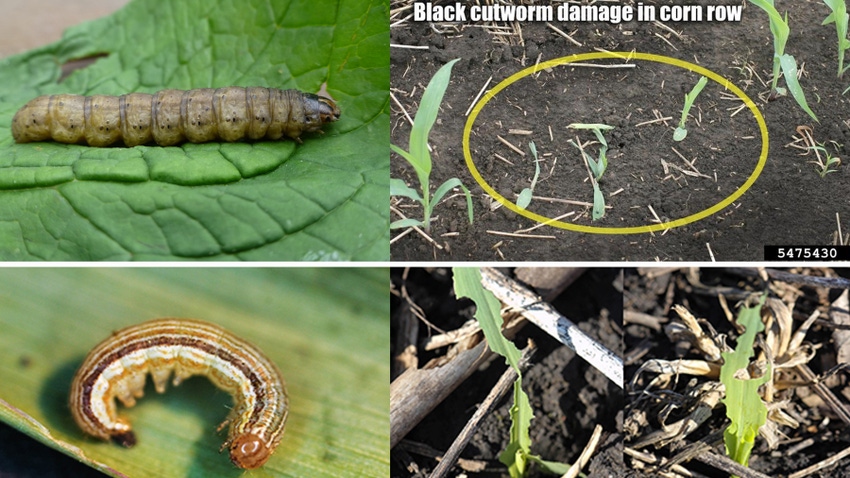March 6, 2023

by Ashley Dean and Erin Hodgson
Spring is upon us, and now is an excellent time to begin thinking about early-season insect pests. There is a suite of insects that overwinter in Iowa, and their potential for creating injury on seeds and seedlings is somewhat predictable. For these established pests, we can use growing degree day (GDD) models to predict when they will be active and when crop injury might occur. However, there are a few pests that cannot overwinter in Iowa and are swept north with strong, southerly winds each spring. Two examples of migratory insects are black cutworm and true armyworm; these pests have unpredictable flight patterns. Therefore, monitoring is required each spring to provide scouting recommendations.
Why we care about black cutworm and true armyworm
Black cutworm moths typically lay eggs on green vegetation (usually cover crops or weeds) once they arrive. Eggs hatch in a week, and young larvae feed on vegetative corn leaves or small weeds. Once they reach the fourth instar, black cutworm larvae can cut plants at or below the soil surface. The larval feeding can seriously injure or kill the plant until corn reaches the V5 growth stage. Yield reductions typically occur because of reduced plant stands that may require replanting.
True armyworm moths lay eggs in similar places to black cutworm. Once eggs hatch, larvae begin feeding on lower leaves of corn plants. Once lower leaves are consumed, larvae feed higher up on the plant. Corn and other grasses are preferred, but true armyworm larvae may feed on soybeans once grass hosts are consumed or terminated. Typically, plants will recover from feeding and outgrow defoliation, but heavy infestations can completely defoliate a field overnight.
Early-season scouting for both pests can be combined with stand assessments and other agronomic scouting activities. Look for missing or defoliated plants. The larvae of both species typically feed during cooler parts of the day and hide when it is warm (soil, crop residue, whorls). If larvae are found, take note of their size: Although larger larvae (usually larger than 1 inch) eat more, they are likely to be done feeding in a few days. Because of the sporadic nature of these two pests, preventive insecticides are not an economical choice. It is best to scout fields and only apply insecticides when larvae are small and actively feeding.
Moth trapping network
Because these moths are unpredictable, Iowa State University has been monitoring black cutworm for at least a decade (true armyworm since 2017) with help from volunteer cooperators across the state. Each February, volunteers respond to a call for cooperators posted on the Integrated Crop Management blog. These volunteers assemble wing-style pheromone traps and place them — usually near a cornfield — on April 1. These traps use a sex pheromone to attract male moths, which get stuck in the trap. Traps are checked at least three times per week until the end of May, and data are uploaded to Ag Pest Monitor and made available to the public on corn.ipmpipe.org/insects.
In hosting this network, our goal is to monitor moth flights into Iowa and provide scouting recommendations to farmers across the state. Each year, we aim to have a robust network that covers the entire state. The data provided are used in a few ways:
Weekly updates are posted on the Integrated Crop Management blog. This includes moth counts by county for each species and notice of any significant flights of black cutworm. A significant flight is when eight or more black cutworm moths are captured over a two-night period in pheromone traps. No such threshold exists for true armyworm, so the goal is to alert farmers about when and where true armyworm moths are active.
Predicted cutting dates for black cutworm are posted to the Integrated Crop Management News page. Following a significant flight, it takes approximately 300 GDD (base 50 degrees F) for larvae to reach the fourth instar, which means they are large enough to cut corn seedlings. We use actual and historical weather data to predict when larvae will reach this stage.
Capturing moths in a pheromone trap does not necessarily mean there will be an economic infestation nearby. Scouting is the only way to determine if black cutworm or true armyworm larvae are present in a field, and whether management is needed. Even if you aren’t participating in the trapping network this year, keep an eye on the Integrated Crop Management page for trapping updates and scouting recommendations for black cutworm and true armyworm in your area. Although moth trapping has already begun for the 2023 season, you can contact [email protected] to get on the list for 2024.
Dean and Hodgson are both entomologists at Iowa State University.
You May Also Like




